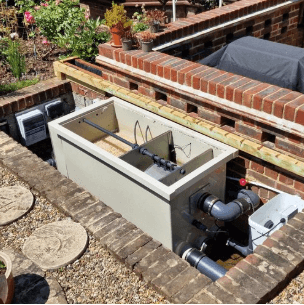Comprehensive Guide to Pond Drum Filters for Efficient Filtration

If you’re passionate about maintaining a clean, healthy, and crystal-clear pond, investing in a pond drum filter is one of the most effective choices you can make. These innovative filters are revolutionising the world of pond filtration, especially in koi ponds and large garden ponds, by automating debris removal and improving water quality like never before.
What is a Pond Drum Filter?
A pond drum filter is a mechanical filter that uses a rotating drum with a fine mesh screen to remove solid waste particles from pond water. As water flows into the drum, particles such as leaves, uneaten food, and fish waste are trapped on the mesh. When the mesh clogs, a water level sensor triggers a cleaning cycle, rotating the drum and spraying off the debris into a waste drain.
This self-cleaning feature is what makes drum filters stand out from traditional pond filters, significantly reducing maintenance and improving efficiency.
Why Choose a Drum Filter Over Traditional Filters?
- Minimal Maintenance: Drum filters are fully automated, requiring little to no manual cleaning.
- High Efficiency: Filters particles down to 60 microns or finer, keeping water crystal clear.
- Durable and Long-Lasting: Built from high-quality materials, these filters can withstand the rigours of outdoor pond environments.
- Energy Saving: Because of their efficient design, they reduce the load on your biological filter and pumps.
- Improved Water Quality: Cleaner water means healthier fish and a more visually pleasing pond.
Ideal Use Cases for Pond Drum Filters
Pond drum filters are perfect for:
- Koi Ponds: Where high fish loads demand superior filtration.
- Large Garden Ponds: To reduce maintenance on large bodies of water.
- Commercial Fish Farms: Where clean water is critical for health and growth.
- Natural Swimming Ponds: When clarity and hygiene are paramount.
Top Features to Look for in a Drum Filter
When shopping for a pond drum filter, you should focus on the following key features:
1. Micron Rating of the Screen
Look for screens that filter down to 60 microns or even 40 microns. Finer screens mean clearer water but may trigger cleaning cycles more frequently.
2. Self-Cleaning System
The automated backwash system is essential. Ensure it includes pressure nozzles, waste drainage, and sensor-based automation for hands-free cleaning.
3. Flow Rate Capacity
Choose a unit that can handle your pond’s gallons per hour (GPH). Undersized units reduce efficiency, while oversized ones may be overkill.
4. Build Quality
Opt for materials like stainless steel or heavy-duty UV-stabilized plastic for maximum longevity.
5. Compatibility with Biological Filtration
A drum filter should be the first stage of filtration, removing solids before the water flows to biological filter media.
Best Pond Drum Filters on the Market
We’ve curated a selection of top-tier drum filters designed to meet the diverse needs of both hobbyists and professionals in aquatic environments.
1. Burtons Combi Drum Filter
A popular choice among koi enthusiasts, this unit combines mechanical and biological filtration in one compact system. Known for reliable electronics and easy installation.
2. Oase ProfiClear Premium Drum Filter
German-engineered, it offers exceptional build quality, a smart control panel, and is suitable for koi ponds up to 30,000 litres.
3. AquaForte Drum Filter
This filter is appreciated for its modular design, allowing users to upgrade components. The stainless-steel drum ensures longevity.
4. Evolution Aqua Drum Filter
With models suitable for both residential and commercial ponds, Evolution Aqua filters are trusted by koi breeders for their performance and reliability.
Installation Tips for Drum Filters
Proper installation is key to getting the most out of your pond drum filter. Here’s how to set it up for optimal performance:
- Location: Install the filter as close to the pond as possible, ideally gravity-fed or in a pump-fed configuration.
- Pre-Filtration Basin: In gravity-fed systems, position the filter in a vortex or settlement chamber.
- Power and Drainage: Make sure there’s electrical access and a nearby wastewater outlet.
- Water Level Management: Drum filters work best when water levels are consistent—ensure no fluctuations to prevent system errors.
Maintenance and Longevity
Thanks to their automatic cleaning cycle, pond drum filters require minimal intervention. However, to ensure years of trouble-free operation:
- Inspect the Spray Nozzles periodically for blockages.
- Check the Control Box for moisture ingress or wiring issues.
- Clean the Waste Drain to prevent clogs from accumulated debris.
- Lubricate Moving Parts, if applicable, based on manufacturer recommendations.
Cost vs Value: Are Pond Drum Filters Worth It?
While drum filters can be more expensive upfront, they pay off in the long term due to:
- Reduced manual labour
- Improved fish health
- Lower disease incidence
- Less need for chemical treatments
- Enhanced water clarity and pond aesthetics
For koi pond owners, especially, these benefits make the investment highly worthwhile.
Environmental Impact of Drum Filters
Pond drum filters contribute to eco-friendly pond management by:
- Reducing waste build-up
- Eliminating the need for frequent water changes
- Minimising the use of algaecides and chemical treatments
Many modern systems are also energy-efficient, using low-voltage motors and smart sensors to conserve electricity and water.
Conclusion: Drum Filters are the Future of Pond Filtration
A pond drum filter is not just a filtration system—it’s a smart investment in the long-term health and beauty of your pond. Whether you’re a hobbyist with a small koi collection or managing a commercial aquaculture setup, drum filters provide the clarity, efficiency, and ease of maintenance that traditional systems simply can’t match.




